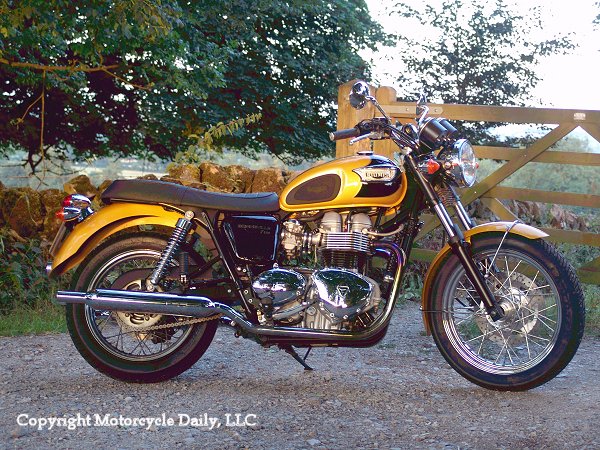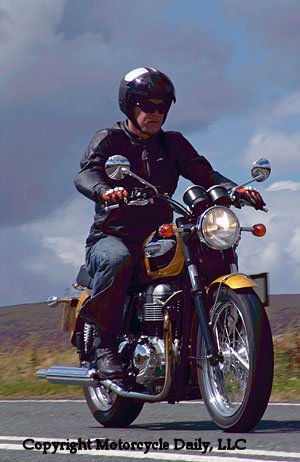
The Bonneville Black and the Bonneville T100 are the first 2007 models Triumph has released. Due to high demand from their dealers, Triumph decided to make them available two months prior to the planned release. For 2007, all Bonneville models now feature a version of the 865cc parallel twin engine from T100, which replaces the 790cc version formerly found in the most basic Bonneville models.
The T100, as the name suggests, can do the staggering speed of 100 mph, the true ton. The original Bonneville was one of the world’s fastest motorcycles at the end of the sixties, and it is this image Triumph has refreshed with the T100. The Bonneville is named after the famed Bonneville Salt Flats in Utah, the site of a majority of the world’s land-speed record attempts, both four- and two-wheeled.
However, these days a 100mph top speed isn’t much to brag about, and the Bonneville’s main selling point are its rugged, classical good looks. The T100 is part of Triumph’s “Modern Classics” range, designed to attract buyers both young and old – basically anyone who appreciates its cool retro look. The Bonneville T100 is a great looking machine with painted steel mud-guards, loads of chrome, pea-shooter exhausts and a hand painted fuel tank.

The seat height is 775mm (30.5″), and the handlebars are placed so that the seating position is upright and comfortable. The dry weight is a claimed 205 kilos (452lbs), but the T100 does not feel too heavy – just solid. The classic double seat is surprisingly comfy, and not much tempts me to ride the ’07 Bonnie like a superbike. The handlebar is narrower than a cruiser and the foot pegs higher. But 30 years of development have made the Bonneville a pure nostalgic choice for the buyer that remembers the sixties. With new and trendy “sixty8” accessories Triumph are targeting the younger buyers too, particularly the ones that live in a city. Anyone with an eye for the appeal of sixties nostalgia will be attracted to the Bonneville.
Steel tubes keep everything in place in the bends, and the Bonneville feels much more like a rider’s bike than any classic looking cruiser. Looking down at the instruments, I spot a classic-looking tachometer next to the speedo. The tach allows me to quantify what I have already understood; the engine gives smooth acceleration all through the rev-range, but above 6,000rpm there is little extra to be gained. Max power is 67bhp@ 7,200rpm, but after max torque @ 6,000 rpm you are just as well off short-shifting into the next gear.
The engine buzzes silent as a sewing machine and, making me miss the extra noise and character the 865cc parallel twin provides when fitted with louder pipes. After riding a Thruxton 900 with loud pipes back-to-back with the T100, I now know what was missing. According to Triumph, a T100 fitted with their optional accessory exhaust will sound identical to the Thruxton I rode.
The engine features twin, electrically heated carburetors. These days, carburetors are more expensive than fuel injection, and Triumph has had to go to great lengths to make the carburettor-fueled Classics range burn clean enough for the first stage of the new Euro 3 standards, which go into effect in 2007. This involves burning off un-burnt fuel before it reaches the atmosphere outside of the engine. Triumph has added an air injection unit near the spark plug to achieve this. As a result, a measly 1bhp is lost on its way between the Keihin carburetors and the rear wheel. The air injection kit barely saves the 2007 models, but in 2008 Triumph will have to change the fuelling again. By then, only fuel injection will be able to save the Modern Classics range from the long arm of emissions regulations.
The Bonneville T100’s parallel twin features the classic 360-degree firing order. The only Bonnie classic that differs from that configuration is the Scrambler with its 270-degree firing order. The engine runs at 3,900 rpm when cruising at 63mph (100km/h) in fifth gear. The five-speed gearbox feels smoother than the gearboxes that I am used to on Triumph’s three-cylinder models, and there’s hardly any “clunk” sounds when changing gears.

Once upon a time, in the latter half of the sixties, 100mph was considered as fast as 186mph is today. The 2007 T100 reaches the ton effortlessly, even on some of the mile long uphill parts on the M1 around Nottingham. But even when pushed in top gear for several miles, there’s no way the T100 will earn a name change to T110. These days it’s not very PC to use top speed as a sales argument, but the Suzuki Hayabusa would have been the T186 after the old Triumph terminology.
There is hardly any vibration at all from the parallel twin engine and the mirrors stay clear in any situation. The bottom end power is good, but the acceleration struggles to impress. There are few surprises, which suits if you like a predictable life on two wheels.
The brakes consist of a two-piston caliper clamping a 310mm disc up front and one powerful 255mm disc with two-piston caliper at the rear – powerful because I found it too easy to lock up the rear wheel on the T100. When riding the Thruxton 900 just after the T100, it was different in that department, as the chance of locking up the rear wheel was less.
With modern Metzeler Z2, tires the braking forces can be concentrated on the front wheel, benefiting stopping distances. The Metzeler tires sits on spoked wheels, 19inch front and 17inch rear with a 130/80 tyre. Ground clearances is more than good enough for some fast Sunday morning rideouts, but get the Thruxton 900 for the TTs. The suspension is firm enough and good quality, with 41mm forks out front and twin shocks at the back that can be adjusted for preload. Stability in the turns is good, and overall the handling can be described as very predictable. The swingarm is also made of steel and contributes to the stable feel.

A big part of the whole Bonneville experience is staring at the machine at home in the garage before and after a ride. Several other brands produce retro-styled machines taking inspiration from the same era as the Bonneville, but none of these carry the credibility that comes with the classic Triumph badge found on the T100’s tank. The polished engine covers are bigger than the average mirror in your home, and feature a smooth surface devoid of lines and details – all the easier to polish up before a ride to the pub or café. The chain sits on the right-hand side, and to test how far the nostalgia goes I flicked a finger at the chain guard to verify it is of metal rather than cheap plastic. Metal it is. The chromed headlight is big, and belies its period-correct appearance by providing sufficient light on a dark night. With a bit of WD-40 I would have been able to use the steering lock, which is separate from the ignition on the right hand side of the steering head.
In the end, if you fancy the retro styling and want all (well, most of) the cool factor of a 60s Bonneville without the typical problems of riding a 40-year old motorcycle, the T100 is an excellent choice. The T100 certainly won’t stick with your mates on modern sportbikes, but it’s a much better ride than a cruiser, while still possessing that classic, chrome and leather appeal.
+
Bonneville heritage, style and the Triumph badge on the petrol tank
Handling
Comfortable
–
Not enough character from that lovely parallel twin in standard trim.
Rear brake locks up the rear wheel too easy.
The 2007 Triumph Bonneville T100 carries a U.S. MSRP of $8,199. Visit Triumph’s website for additional details and specifications.





